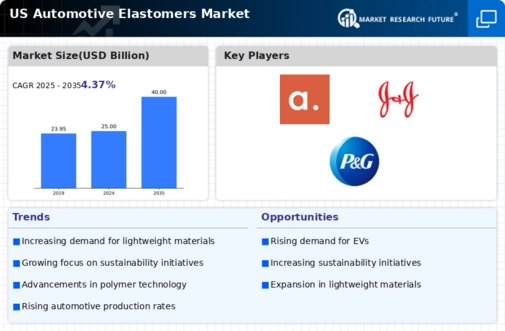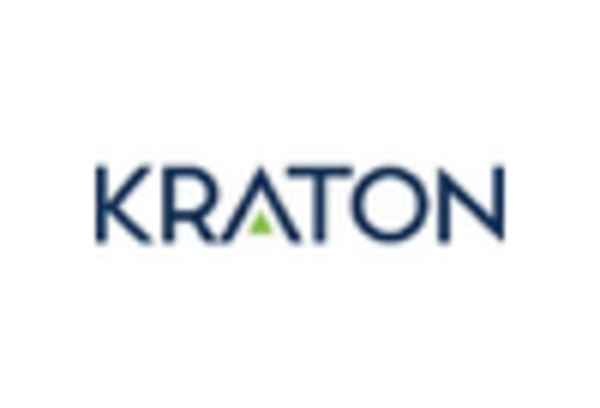Rising Electric Vehicle Adoption
The automotive elastomers market is poised for growth due to the rising adoption of electric vehicles (EVs) in the US. As the automotive industry transitions towards electrification, the demand for specialized elastomers that can withstand higher temperatures and provide better insulation is increasing. In 2025, it is estimated that EV sales will account for around 20% of total vehicle sales in the US, creating a substantial market for elastomers tailored for electric vehicle applications. This shift not only enhances the performance of EVs but also drives innovation within the automotive elastomers market, as manufacturers seek to develop materials that meet the unique requirements of electric drivetrains.
Increasing Demand for Fuel Efficiency
The automotive elastomers market is experiencing a notable surge in demand driven by the automotive industry's focus on enhancing fuel efficiency. As manufacturers strive to meet stringent fuel economy standards, the incorporation of lightweight materials, including elastomers, becomes essential. These materials contribute to reducing vehicle weight, thereby improving fuel consumption. In 2025, the average fuel economy for new light-duty vehicles in the US is projected to reach approximately 25 mpg, necessitating the use of advanced elastomeric materials. This trend indicates a robust growth trajectory for the automotive elastomers market, as automakers increasingly prioritize materials that support their fuel efficiency goals.
Regulatory Compliance and Safety Standards
The automotive elastomers market is influenced by stringent regulatory and safety standards. In the US, regulations governing vehicle emissions and safety are becoming increasingly rigorous, compelling manufacturers to adopt materials that meet these requirements. For instance, elastomers used in sealing and insulation must adhere to specific performance criteria to ensure vehicle safety and environmental compliance. As of 2025, the automotive industry is expected to invest over $10 billion in research and development to meet these evolving standards, thereby driving demand for high-performance elastomers. This regulatory landscape presents both challenges and opportunities for the automotive elastomers market, as companies innovate to stay ahead.
Consumer Preference for Customization and Aesthetics
Consumer preferences for customization and aesthetics in vehicle design are increasingly influencing the automotive elastomers market. As consumers seek personalized vehicles, manufacturers are responding by incorporating elastomers that offer both functional and aesthetic benefits. This trend is particularly evident in interior applications, where elastomers are used for trim, seals, and other components that enhance the overall look and feel of the vehicle. By 2025, it is projected that the demand for customized vehicle interiors will grow by 15%, prompting manufacturers to innovate within the automotive elastomers market to meet these evolving consumer expectations. This focus on aesthetics, combined with functionality, is likely to drive further growth in the sector.
Technological Innovations in Manufacturing Processes
Technological innovations in manufacturing processes are benefiting the automotive elastomers market by enhancing material performance and reducing production costs. Advances in polymer science and processing techniques are enabling manufacturers to create elastomers with superior properties, such as increased durability and resistance to environmental factors. In 2025, it is anticipated that the adoption of advanced manufacturing technologies, such as 3D printing and automation, will increase by approximately 30% in the automotive sector. This shift not only streamlines production but also allows for greater customization of elastomeric components, thereby expanding the application range within the automotive elastomers market.

















Leave a Comment